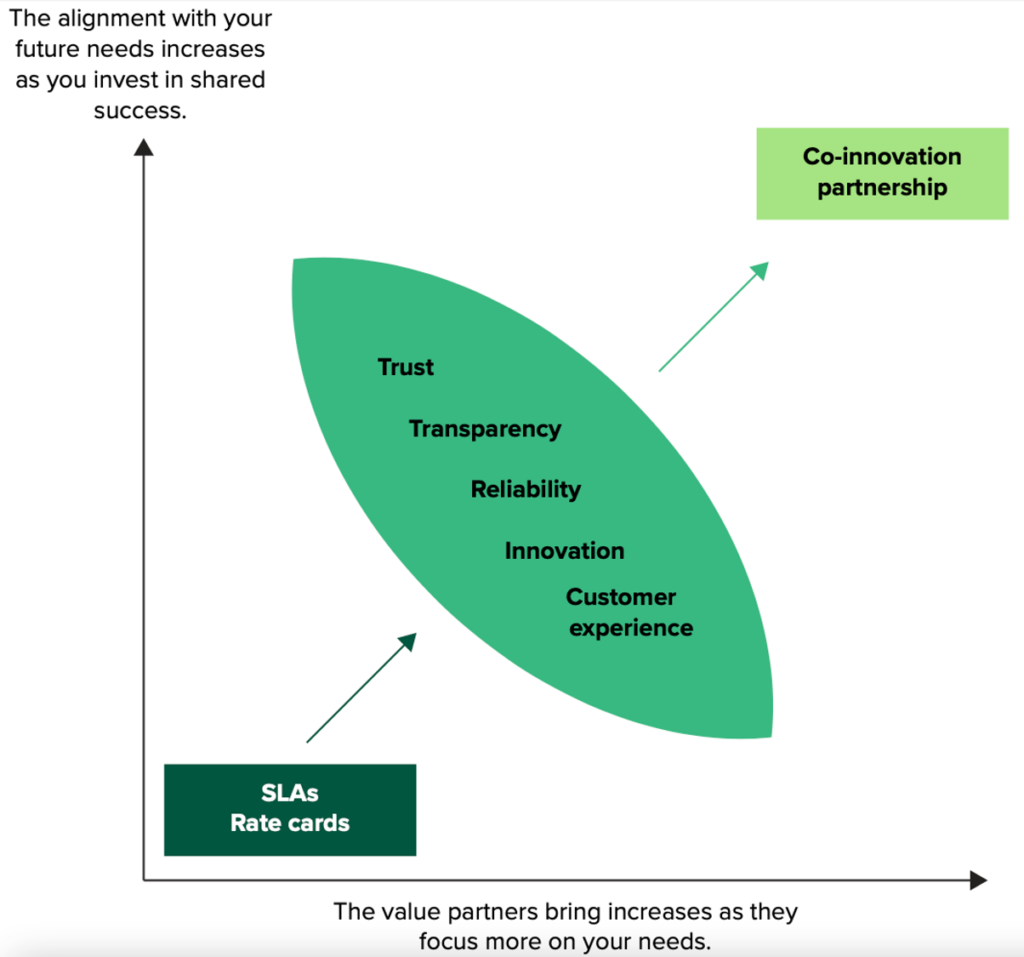Future Fit Companies Build Success Through Partner Ecosystems
In our recent research, we have demonstrated how a future fit tech strategy gives your company the foundations for customer and business success. And we have determined that companies that are customer obsessed grow 2.5 times faster than others. Creativity — finding new solutions to old problems and making breakthroughs to new business models, new products, and new ways of working — give you the power to differentiate and grow. (For more on creativity, listen to this episode of the What It Means podcast).
But no company can do this alone. Firms embracing a future fit strategy rely on the value coming from outside. As a technology executive, you have the authority and responsibility to extract and orchestrate the value of 100,000 business and technology parts available over the cloud — parts that include:
- Cloud platform vendors like Amazon, Google, and Microsoft
- Software platform and specialty vendors by the thousands
- Insights- and outcomes-focused business process outsourcing (BPO) vendors
- Third-party services providers to help you identify and orchestrate the value of all those continuously improving parts.
We call this approach to finding and orchestrating the technology and capability you need to assemble solutions “innovation through ecosystems.”
Innovation through ecosystems happens when organizations actively collaborate with their cloud, software, business, and services providers — value aligned through common purpose and financial incentives.
The key to innovation through partner ecosystems is lining up your platform and practice needs against the rapidly advancing capabilities available over the cloud. Mitigating the risks, managing deeper dependencies, and orchestrating the value of these complex ecosystems requires a fresh, much deeper look at the partners you most rely on.
The Key Is Stronger Value Exchange, Particularly With Your Strategic Partners
The old rate card, RFP, and service-level agreement (SLA)-driven models don’t work well in a future fit enterprise, where transformation is continuous, multidimensional, and uncertain and where strategy and implementation are tightly coupled. That’s why enlightened tech leaders are looking beyond capabilities and price to embrace a new technology and services paradigm built on a clearer value exchange that we call “co-innovation partnership.”
The value exchange is highest if you and your partners focus on trust, transparency, reliability, innovation, and your own customer experience (see the figure). All parties have work to do to get the most out of the vast and expanding universe of value available in cloud ecosystems. A co-innovation partnership works when:
- Vendors and providers assume more risk and are rewarded based more on outcomes. Cloud, software, and BPO providers do this already. To traditional services customers, this may sound impossible, but Forrester Analytics survey data found that 35% of global services decision-makers plan to increase their use of outcome-based pricing with third-party services providers in 2021.
- Business, operations, and technology executives co-invest and co-govern. Co-innovation success only happens when technology leaders and other C-suite executives invest time and energy in these relationships. Vendors and providers need to know your priorities and that you will identify and overcome internal barriers to success.
- Both sides benefit from creating new value and intellectual property. For vendors, it’s their intellectual property. For services, intellectual property should be on the table for both sides. It may be that you make more money by sharing your secret sauce with a provider, or even with a community.

Focus Co-Innovation Partnership On Your Most Strategic Vendors
Select strategic partners based on their contribution to your business outcomes. These aren’t the hundreds of vendors you’re working with today, nor is “partner” a euphemism for vendors that consume large shares of your budget. Instead, focus your attention on the dozen or so truly strategic partners that are most important to your success and where both the scale and strength of the relationship are highest.
- Favor co-innovation partners with shortlist preference in future deals. Extend and strengthen your best partnerships, and try to fix important relationships before they fail the partnership test.
- Move away from vendors that command your budget but don’t differentiate you. Shift commodity relationships to a different management track if vendors that provide a service are not strategic to your future growth.
- Co-innovate with startups and specialists to tap into the cutting edge. Spot up-and-coming vendors that consistently deliver excellent customer experience or show superior levels of innovation. Invite them to inspire you, to accomplish something different, and to do it fast.
As part of Forrester’s future fit technology strategy research, we’ve written a new report called “Co-Innovation Partnerships Define Your Future Fit Vendor Strategy” to illustrate how tech executives as well as business and marketing leaders can get the most value from their strategic vendor and services provider partners. If you would like to set up an inquiry, feel free to email tschadler@forrester.com, djones@forrester.com, or bcameron@forrester.com.
